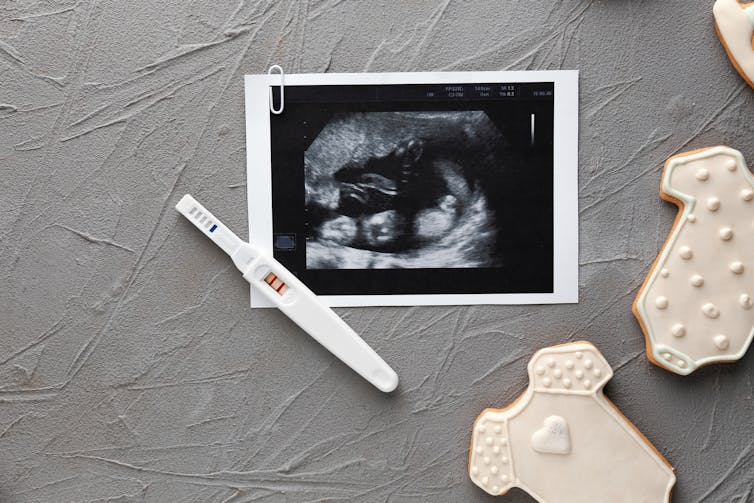This article is republished from The Conversation under a Creative Commons license. Read the original article here.
The Centers for Disease Control and Prevention reported on May 15 that the number of births in the U.S. is down 2% – “the lowest number of births in 32 years.”
These reports were met with surprise and alarm. USA Today, for example, led with the headline “A lot of empty kindergarten rooms.”
However, this recent decline fits with global trends and isn’t unprecedented in U.S. history. As a demographer who studies fertility trends, what strikes me as anomalous is not the recent drop, but the previous high fertility “bubble.”
Unusually High Rates
The U.S. maintained surprisingly high fertility rates for a long time.
After the baby boom of the 1950s and 1960s, fertility in the U.S. and other wealthy countries fell during the 1970s. However, the U.S. steadily rebounded, even as rates in most other wealthy countries stayed low or fell even lower.
By 1990, there were 2.1 children per woman in the U.S., compared to 1.4 in Spain and 1.5 in Germany, for example.
This gap between the U.S. and other developed countries baffled demographers through the 1990s and early 2000s. Public policy choices couldn’t explain it. The U.S. maintained its high fertility rate even while being comparatively weak on “pro-fertility” policies like family leave and financial support for parents.
Several factors propped up the fertility rate. The U.S. had a steady flow of immigrants from higher-fertility countries. It also had a persistently high unintended pregnancy rate; a flexible labor market that allowed parents to exit and re-enter the workforce; and a strong, stable economy.
Fluctuation is Normal
The recent drop in fertility brings the U.S. more in line with peer countries.
In 2018, the U.S. dropped to 1.73 children per woman. This number is well within the range of similar countries, and even remains toward the top of the pack. Only a few wealthy countries – including France, Australia and Sweden – have higher fertility rates than the U.S., and differences are small.
It’s normal for fertility rates in wealthy countries to go up and down. People tend to adjust the timing of births to take advantage of a “good” year – such as one when high state benefits are offered – or avoid a “bad” year – such as one with high economic uncertainty.
Spain’s fertility declined from the 1970s to the early 1990s, as women increasingly joined the labor market but husbands didn’t share the load at home. (Perhaps working and taking care of three kids was more than most women wanted to handle.)
In Russia, fertility fell steadily following the economic and political shock of the collapse of the Soviet Union. It later climbed back.
And, between the 1990s and early 2000s, Sweden’s fertility fell and then rose, in part due to changes in the timing of births, the economy and the state’s generous supports for parents.
There are a number of possible explanations for the recent dip in U.S. The Great Recession is certainly important, and its effects linger even as the economy has recovered. A Gallup poll indicates that, for the past several years, Americans’ “satisfaction with the way things are going in the U.S.” has remained substantially below levels in the late 1990s and early 2000s.
In addition, declines in fertility rates have been particularly steep among younger people, who are disproportionately affected by high student loan debt and may find it harder than previous generations to get on their feet economically.
However, if economic conditions improve for these young people, research suggests they are likely to “make up” many of these births later in their lives. Whether these younger cohorts do or not will be more consequential than the current yearly birth rate.
Finally, part of the drop in overall fertility is due to declines in unintended birth rates. Such declines have been a public policy goal for decades —- so the dip in fertility should be seen as a good thing, not a cause for gloom.
Keep it Steady
The fertility rate in the U.S. isn’t alarming, yet. But a continued drop could cause problems.
There are at least two scenarios that would create challenges. The first is a persistently low fertility rate that leads, over time, to a shrinking population. A population with a sustained fertility rate of 1.3 children per woman, for example, will quickly contract.
The second is a large, rapid fall in fertility. That eventually creates a lopsided population with more old than young people – making it hard, for example, to sustain policies like social security.
Both of these scenarios could happen, but it’s important to emphasize that the U.S. is not currently experiencing either one. However, I believe that it would be wise implement policies that would make it easier for those who want to have children to do so, such as paid family leave and subsidized child care. Also, immigration has helped improve the U.S.‘ demographic profile in the past, and could continue to do so in the future.
The U.S. is unlikely to return to the exceptionally high fertility rates we had before the last recession, but the current rate is one that many countries would be thrilled with.
This is an updated version of an article originally published on May 30, 2018.![]()

